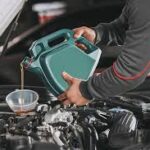
Have you ever thought about the air in your tires? While it might not seem like a big deal, your car’s tire pressure impacts everything from fuel efficiency to safety. Ignoring this basic aspect of car maintenance can cost you money and potentially put you in danger. Let’s break down why tire pressure matters and how keeping it in check can help you save on fuel and drive with peace of mind.
What Is Tire Pressure and Why It Matters
Tire pressure is simply the amount of air inside your tires, measured in pounds per square inch (PSI). Proper pressure is crucial for ensuring your tires make adequate contact with the road, providing traction, and delivering a smooth and efficient ride.
How Proper Tire Pressure Saves Fuel
Did you know that low tire pressure can reduce your car’s fuel efficiency by up to 10%? When your tires are underinflated, they have more rolling resistance, which means your engine has to work harder to move the car forward. This extra effort requires more fuel, hitting your wallet and harming the environment.
The Safety Benefits of Correct Tire Pressure
Driving with underinflated or overinflated tires can compromise your car’s handling and stability. Underinflated tires create uneven wear and increase the risk of blowouts, especially at high speeds. Properly inflated tires ensure you have reliable traction and braking power when it matters most.
How to Check Your Tire Pressure
- Get a Reliable Tire Gauge: Invest in a quality gauge to get an accurate reading.
- Find Your Recommended PSI: This can typically be found in your owner’s manual or on a sticker inside the driver’s door.
- Check Tires When Cold: Tires should be checked when they haven’t been driven for a few hours to get an accurate PSI.
- Adjust Accordingly: If the PSI is too high or low, add or release air as needed.
Signs Your Tire Pressure May Be Off
A few signs can signal your tire pressure may need adjusting:
- Poor Fuel Efficiency: Are you filling up more often than usual?
- Uneven Tire Wear: Notice any unusual wear patterns?
- Handling Issues: Does the car feel unstable or difficult to handle?
The Impact of Temperature on Tire Pressure
Temperature changes affect air pressure in your tires, with every 10°F drop reducing PSI by about 1-2 points. This means winter can lead to underinflated tires if you’re not checking regularly. In summer, your tires can become overinflated if they’re left unchecked.
How Tire Pressure Affects Tire Longevity
Maintaining proper tire pressure can extend the lifespan of your tires. Underinflated tires wear out faster because more of the tire’s surface contacts the road. Overinflated tires wear down in the center tread. Keeping the right PSI helps distribute wear evenly.
Tire Pressure Monitoring Systems (TPMS)
Most modern cars come with a TPMS that alerts you when tire pressure is too low. This system is beneficial, but it shouldn’t replace regular manual checks. Sometimes, the sensors can miss gradual changes, and they don’t always alert for overinflated tires.
Best Practices for Maintaining Tire Pressure
- Check Monthly: Tire pressure should be checked at least once a month.
- Consider Seasonal Adjustments: Make adjustments for extreme temperature changes.
- Rotate Tires: This promotes even wear, extending tire life.
- Keep an Eye on Spare Tire: Your spare needs proper pressure too, in case of emergencies.
Common Myths About Tire Pressure
- Myth: Overinflating Tires Saves Fuel
Fact: Overinflation increases center tread wear and reduces tire life without substantial fuel savings. - Myth: TPMS is Enough
Fact: TPMS can’t always detect slow leaks or overinflation. - Myth: You Only Need to Check Pressure in Winter
Fact: Temperature affects PSI in all seasons, so regular checks are essential year-round.
Frequently Asked Questions (FAQs)
1. How often should I check my tire pressure?
It’s recommended to check your tire pressure at least once a month and before long trips.
2. What should I do if my tire pressure warning light comes on?
Find a safe place to stop and check each tire’s pressure using a gauge. Adjust as necessary.
3. Can low tire pressure damage my car?
Yes, low pressure can lead to uneven tire wear, increased fuel consumption, and even potential damage to suspension components.
4. How do I know the correct tire pressure for my car?
You can find the recommended PSI in your vehicle’s manual or on a label inside the driver’s door frame.
5. Does tire pressure really affect fuel efficiency that much?
Absolutely. Low tire pressure increases rolling resistance, which makes your engine work harder, leading to more fuel consumption.
Conclusion: Driving Safer, Saving More
Taking a few minutes each month to check and adjust your tire pressure can help you save on fuel, drive more safely, and extend the life of your tires. In the long run, keeping your tires properly inflated is a small effort with substantial rewards—both for your wallet and your well-being.







Top Maintenance Tips to Improve Fuel Efficiency - MSO LIMPID
[…] tires create more rolling resistance, which forces your engine to consume more fuel. Check your tire pressure at least once a month, especially during seasonal changes. Properly inflated tires can improve fuel […]